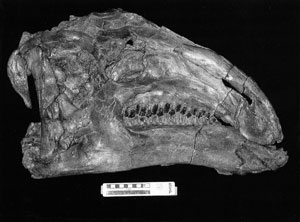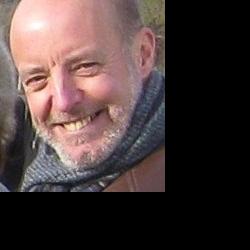Biography
Undergraduate degree (Leeds University), Postgraduate degree (King's College London & The Natural History Museum). Royal Society Postdoctoral Fellowship (Royal Belgian Institute of Natural Sciences, Brussels). Lecturer in Biological Sciences (Queen Mary College London). Departmental Lecturer in Zoology (Oxford University) & College Lecturer (Brasenose College Oxford). Head of Palaeontology Division, The Nature Conservancy Council, GB (1987-1991). Director, Sedgwick Museum of Earth Sciences (1991-2011).. Asher Tunis Distinguished Research Professor, Smithsonian Institution, Washington DC. Odell Fellow, Christ's College Cambridge. University Professor in Vertebrate Palaeobiology.
Research
Vertebrate Palaeobiology

Iguanodontian Evolution
The skull pictured is that of the remarkably well-preserved dinosaur (Equijubus normani) that was collected in Inner Mongolia. Its cranial anatomy is remarkably similar to taxa such as Iguanodon and its near relatives (long-studied from material collected in Britain and Europe). Equijubus adds further detail to our understanding of the richness, variety and geographic distribution of iguanodontian dinosaurs during the tectonically and geographically dynamic 'middle' Cretaceous Period. My research has been exploring the distribution and evolutionary history of these basal iguanodontians in relation to the origin of their descendants: the hadrosaurian ('duckbilled') dinosaurs of the Late Cretaceous Period (Norman 2014, 2015). Discerning the degree of relationship between such widely distributed iguanodontian taxa, the pattern in which they seem to acquire duck-bill-like anatomical characters as well as their stratigraphic ranges, is central to the development of an understanding of the factors (local, environmental, tectonic) that influenced the evolutionary history of the group as a whole.
This aspect of my work focuses upon exploring the factors that affected iguanodontian diversity during the Mesozoic by integrating systematics, anatomy, functional morphology, implied physiology, ecology and geology within an overall phylogenetic picture.
Iguanodon and its congeners
For nearly two centuries the name Iguanodon has signified a type of dinosaur that is iconic in a number of respects: it was one of the three founding members of Richard Owen's "Dinosauria"; it is the 'classic' Wealden dinosaur and it appears on the coat of arms of the town of Maidstone in Kent; it has a concrete effigy at Crystal Palace Park in London. In the 1870s dozens of near-complete skeletons of this animal were discovered in Belgium and are now displayed in Brussels and casts of one skeleton are on display in most of the major museums around the world, so we understand the dinosaur very well ... or so one might suppose. I have published monographs on the Belgian Iguanodon bernissartensis material, as well as the closely related genus Mantellisaurus atherfieldensis. My recent research has focused on the Wealden succession and has shown that "Iguanodon" cannot be considered to be just one genus from SE England. The Wealden represents a long span of time and Iguanodon-like dinosaur remains have been discovered throughout this time period: do they all pertain to the same animal? The simple answer is: No!
Recent publications have demonstrated the existence of at least four distinct genera of Iguanodon-like animals: Iguanodon, Mantellisaurus, Barilium and Hypselospinus (Norman, 2010-2015). These have been described, following painstaking research on ancient collections, all of which had conspired (through a lack of understanding) to mix all these distinct animals together. The new results permit a more a more detailed picture of diversity change within the Wealden and has prompted systematic analyses that have revised our understanding of ornithopod and iguanodontian evolution.
Recent new discoveries made at a quarry near Bexhill have revealed more associated remains of iguanodontian dinosaurs (and an associated fauna) that impinge on our understanding of early Wealden faunas (in preparation)
Current Research: Dinosaur Relationships and New Discoveries
Painstaking reconstruction of species that are entirely new to science, or of ones that have been perhaps poorly described in the past, greatly improves our understanding of the quality and diversity of vertebrate life. Recent work has focused on the very earliest ornithischian dinosaurs. A detailed monograph on Heterodontosaurus (Norman et al., 2011 - from the Early Jurassic of S. Africa) prompted subsidiary questions concerning the fundamental relationships between the major groupings of dinosaurs: Ornithischia, Theropoda and Sauropodomorpha. Recent research exploring such questions has led to the publication of papers (Baron et al., 2017b,c) that challenge our understanding of dinosaur relationships that have stood essentially unchallenged for more than 130 years.
Current work has been focused on describing, for the first time, the very important Early Jurassic armoured dinosaur Scelidosaurus, whose skeletal remains have come almost exclusively from the Liassic cliffs just east of Lyme Regis in southern England. A series of monographs have now appeared (Norman 2020a,b,c; 2021) that focus on the preserved anatomy, biology and relationships of this animal, and two more papers (dermal bone histology & a digital atlas of the skull) are in preparation.
Work continues on dinosaur origins, with a particular focus on the timing of acquisition of the anatomical characters associated with the unique ornithischian bauplan and has involved collaborations between myself, Matthew Baron, Rodrigo Müller and Mauricio Garcia. The preliminary results from this research have been submitted for publication.
Other strands of current research include functional investigations on the anatomy, functional morphology and evolution of limb posture in early archosaurian reptiles (notably the origin of bipedality among lepidosaurs, archosaurs and related forms); and on-going investigations into palaeo-engineering (using finite element modelling) as a means of deducing structure-function relationships in fossil organisms.
Serendipitous Research Directions
Work (undertaken in collaboration with the late Martin Brasier, Oxford and Alex Liu of this Department) on the discovery of a partial cranial endocast (the naturally infilled cast of the brain cavity) of an iguanodontian, that was collected on the foreshore near Bexhill-on-Sea, Sussex, resulted in the discovery of mineralized (in the form of collophane - calcium phosphate, and siderite - iron carbonate replacement) portions of the meninges (tough tissue sheath-like coverings of this dinosaur's brain) in association with blood vessels running through and between the meninges. More surprisingly there appears to be partial preservation (in collophane) of superficial patches of the underlying cortex and the very fine capillary networks (lined with siderite) that permeated the cortex. This extraordinary discovery was published quite recently (Brasier et al, 2018). Deducing the chemistry of the environment that must have prevailed at the time of burial of this specimen, in order for such soft-tissue preservation to occur, proved extremely interesting.
Recent discussions following a visit to Rod Scheetz at the Museum of Paleontology at Brigham Young University (Utah) has led to a joint research project focused on the skeletons of several completely new iguanodontian dinosaurs from the 'middle' Cretaceous Cedar Mountain Formation of Utah; this research will be on-going for the next few years.
Preparations are also being made to develop a research project on the Wealden of SE England and the stratigraphic horizons associated with the area that was historically recognised as "Tilgate Forest". Many ancient quarries in and around the village of Cuckfield yielded the first Iguanodon remains ever illustrated and described; these fossils were collected by Gideon Mantell and many are now in the collections of the Natural History Museum. Preliminary work on this historically very important material reveals that it comprises bones that belong to a number of distinct Iguanodon-like taxa; this suggests that several distinct geological horizons must have been mined in this area. Improving our understanding the stratigraphic geology of these quarries and the provenance of the original material is vital to determining the status of the holotype and other material that has been collectively referred to the genus Iguanodon.
Galapagos Research
On the Cambridge Charles Darwin - Galagagos Islands Trust Fund I am also responsible for supporting research in a diverse range of subject areas associated with the Galapagos Archipelago. Currently the Trust has funded a postdoctoral (Junior Research Fellow @ Christ's) to work on the volcanic evolution of the archipelago (Dr Mike Stock - Mike has recently taken an academic post at Trinity College Dublin), the effects of urbanisation on Darwin's Finches (Dr Kiyoko Gotanda), and has sponsored a Masters degree on Conservation Management (Ms Lucia Norris) and lately Dr Katie Dunkley has been appointed as the 2nd Junior Research Fellow (Galapagos Reef Ecology). I have also published research on Darwin as a geologist as well as his more specific insights into the geology of the Galapagos Islands, both individually and in collaboration with Sally Gibson (Cambridge, Earth Sciences) and Sandra Herbert (University of Maryland).
Publications
ORCID link: https://orcid.org/0000-0003-0101-428X
Teaching and Supervisions
Research Group Members:
Luke Grinham - Locomotor capacity and the origin of facultative bipedality in archosaurs and lepidosaurs - Editor: Nature
Matthew Baron - The ornithischian bauplan and dinosaur origins - Barrister in Law
Collin VanBuren - The structure, function and environmental sensitivity of amphibian skin - AAAS Science & Technology Policy Fellow (Washington DC)
Paul Upchurch - Cetiosaurus and the problem of sauropod systematics & phylogeny - Professor, University College London
Paul Barrett - Dinosaur herbivory - Professor, Natural History Museum, London
Emily Rayfield (Felix) - Cranial mechanisms in theropod dinosaurs - Professor, University of Bristol
Richard Butler - Ornithischian origins and systematics - Professor & Lapworth Curator, University of Birmingham/Lapworth Museum
Roger Benson - Megalosaurus and the problem of basal theropod systematics - Professor, Oxford University
Hilary Ketcham (Benson) - The systematics of pliosaurs - Curator, Oxford University Museum of Natural History
Susannah Maidment (Lanaway) - Stegosaurian anatomy and systematics - Researcher-Curator, Natural History Museum, London
Jason Moore - Taphonomy and the estimation of populations and diversity in the fossil record - Associate Professor, University of New Mexico, USA
Laura Porro (Lowe) - Cranial mechanisms in Heterodontosaurus - Assistant Professor in Anatomy, University Colllege London.
Marcela Gomez-Perez (Noe) - Anatomy and systematics of a new Colombian pliosaur - Associate Professor, University of the Andes, Bogota, Colombia
Claire Slater (Hyslop) - Models of mammalian biogeography and vicariance - Lawyer (Intellectual Property Rights)
Craig Hunn - Vicariance: modelling the fossil record - HM Government (FCO)
Sarah Sangster - Dimorphodon: osteology and pterosaur systematics - Teacher, Solihull/Birmingham
Chloe Marquart - Camptosaurus: its anatomy, variation and systematics - Oakland Museum, California, now lives in Tromso, Norway.
Katherine (Kitty) Thomas - Archosaur anatomy and systematics - Museum Education Officer
Ian Jenkins - The cranial mechanics of gorgonopian synapsids - Dentistry
Alex Burton - Taphonomy of the Wealden environment - Manager, Accenture
Laura Canning (Gerlach) - Megalosaurus - Did not complete thesis
Other Professional Activities
Editor: Zoological Journal of the Linnean Society (1986-1996)
Associate Editor: Zoological Journal of the Linnean Society (1996-present)
Manager/co-ordinator: The Cambridge University Charles Darwin and Galåpagos Islands Trust Fund

